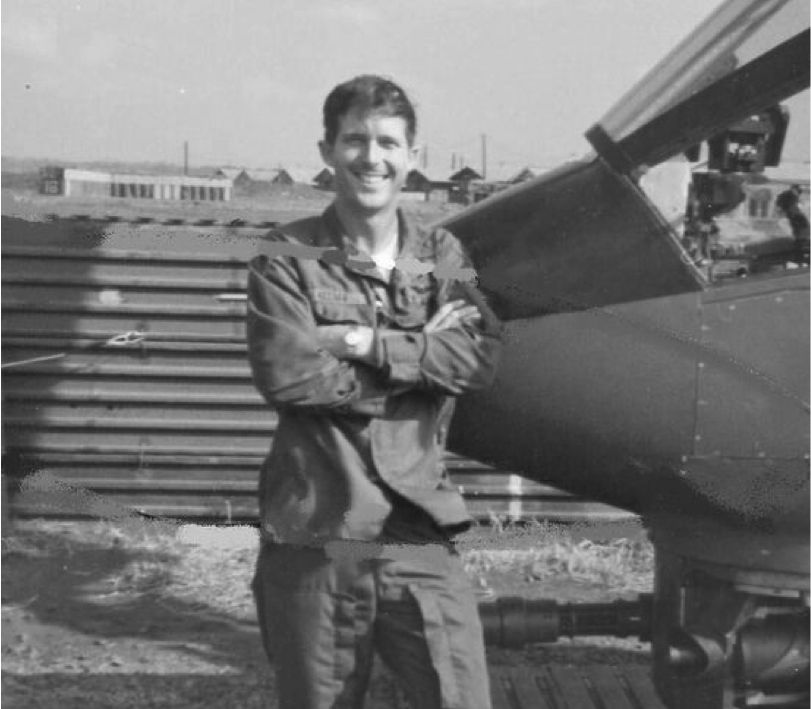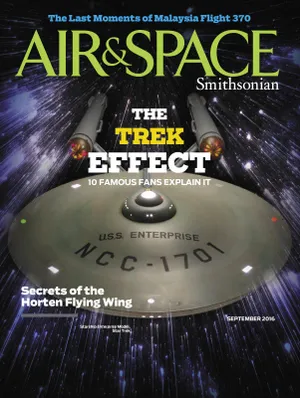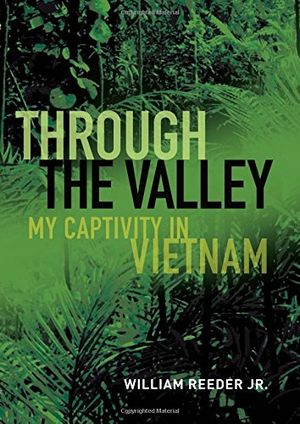Shot Down in Vietnam
A former U.S. Army pilot’s memoir of combat and captivity.
/https://tf-cmsv2-smithsonianmag-media.s3.amazonaws.com/filer/6e/8b/6e8b2203-04e3-443a-87d0-91e16d6db85a/hanoihilton1973jpeg.jpeg)
William Reeder Jr., who served two tours in Vietnam as a U.S. Army pilot, was shot down on May 9, 1972, while flying a mission in a Bell AH-1 Cobra helicopter. He barely survived a forced march along the Ho Chi Minh Trail, only to become a prisoner in Hanoi. Through the Valley is a deeply moving memoir of combat aviation in Vietnam and the POW experience. Senior associate editor Diane Tedeschi spoke with Reeder in July.
Air & Space: Why did you decide to write this book?
Reeder: I wrote the book because I had to. The story has been inside me since I came home from Vietnam. I’ve wanted to write the book for years, but I just didn’t have the time. I returned to active service as a military officer and Army aviator and was busily engaged in command and staff positions of increasing responsibility. There just wasn’t time to write.
Once I started, I found the task to be much more difficult than I’d imagined. I’d talked about my experiences many times over the years, but I never got below the surface of highlighting key events. In writing this book, I had to take myself back there, re-immerse myself in those places, and dig deeply to resurrect the details—the excruciating details—of all that had happened to me. I’d often go to bed late at night, deeply disturbed, falling into troubling dreams I’d not dreamed for years.
I made a concerted effort to recount events exactly as they happened. Where my recollections were dulled with the passage of time, I conducted research and interviewed other participants to ensure accuracy. I wanted the book to be factual and give an honest portrayal of me and what I and those around me experienced. I hope I have done that. The story is crudely graphic in places, but that’s what it was like at the time. The reader sees a real person dealing with the exhilaration and terror of war and the agony of captivity.
Based on your experience with the OV-1 Mohawk, what is your opinion of the aircraft?
I flew Mohawks on my first tour of duty in Vietnam from 1968 through 1969. It was an extraordinary airplane. It was a high performing turboprop, capable of any aerobatic maneuver short of prolonged inverted flight. Top speed was an impressive 386 knots in a dive, and it could absorb unbelievable combat damage and keep on flying. There was no better reconnaissance and surveillance airplane available in the world, and its loss was never rectified until the arrival of advanced drone technology in recent years. When the Mohawk was taken out of service, the ground commander lost an important tactical reconnaissance capability.
Why did you decide to leave flying the OV-1 and take up flying the AH-1 Cobra? Did you prefer one mission over the other?
I loved the Mohawk. It was pure joy to fly. I came to love the daytime visual reconnaissance missions, largely because we were armed and got to engage a lot of targets. Our weapons were for self-defense, but at the end of every mission, we would contact an Air Force forward air controller who would identify targets for us to strike. We rarely came home with any ordnance still onboard.
The Army sent me to college to complete my bachelor’s degree between Vietnam tours. During that time, the decision was made to remove the armament from the Mohawks—something about a violation of roles and missions agreements between the Army and Air Force. At any rate, when I found I could not return to Vietnam flying armed Mohawks, I asked if I could get a helicopter transition and qualify in Cobra gunships en route back to Vietnam. My assignment officer gladly granted my wish, and I returned to Vietnam on my second tour as a brand-new Cobra pilot.
The mission I preferred was guns, be it in an armed OV-1 Mohawk airplane or an AH-1G Cobra attack helicopter. The machines are quite different, but the mission is what grabbed my fancy as a young man. There were the guns, and there was the special-operations aspect of each of my tours of duty. My Mohawk unit flew classified missions in support of high-level intelligence requirements. My Cobra unit flew highly classified missions in support of special operations teams. I loved them both—about equally. I cannot imagine having not flown either one of them.
What is your opinion of the Cobra? Did it get the job done?
The Cobra was superb. It was the first U.S. Army helicopter designed specifically as a gunship. It sported seven and 19-shot rocket pods on its stubby wings and mounted a 7.62 mini-gun and 40 mm grenade launcher in the moveable nose turret. Some of our aircraft, mine included, also had a 20 mm Vulcan Gatling gun under one wing.
Our Cobras were heavy in Vietnam and difficult to hover on a hot day with full ordnance and fuel. Nonetheless, once airborne there was not a better close support weapons platform at the time. Our mission had us routinely covering the hot, tactical emergency, extraction of special forces teams with us firing within a few yards of friendlies.
It was a tremendously rewarding mission, and I’ve never felt more at one with a machine than I did with the Cobra on that second tour of duty. I later flew AH-64 Apaches, a much more advanced and sophisticated aircraft with much more power and maneuverability. The Apache is great, but in my heart, I’ll always love the Cobra more.
As a combat pilot, how did you handle the stress of knowing there were so many things out of your control?
I guess I never worried about it. That doesn’t mean I wasn’t often concerned or afraid. I got at least anxious and sometimes downright scared when flying missions in heavy enemy fire. I’d focus on the tasks at hand and do them. There was no time to dwell on the danger while engaged in combat missions. There was too much else to focus on. We were well-trained and we executed that training. We did what had to be done.
In Vietnam, we were able to relieve the post-mission stress by going to our small unit club, and throwing down several drinks while telling tall tails at the bar. Drinking and camaraderie were the biggest stress relievers in both units I served with in the war—that and letters from home.

What were the two worst things about being held captive?
The two worst things were the loss of freedom and wondering about my family—what they knew and how they were handling it. I find it impossible to adequately describe what it is to lose your freedom. When I was taken prisoner, my heart sank. I had an awful feeling in the pit of my stomach—a hundred times worse than anything I’d ever experienced before. My whole world fell out from under me in that instant.
I’d been shot down, badly wounded. I had a wound from a shell fragment in my right ankle and my back was broken. I had superficial wounds on my face, and was burned on the back of my neck from the fire and explosion on impact. But as bad as things were, I was still free. I had evaded a large number of enemy troops for three days. I still made my own decisions. The instant I was captured, that changed. From that moment on, I did what the enemy directed at the times they told me. I’d wake and sleep and eat on their command. I had no control over my physical actions beyond struggling to stay alive. What I did retain control over was my mind, and I took care to keep that as active and positive as possible.
The other worst thing was wondering about my family. I knew the routine. An officer and chaplain had come to my wife and parents to personally notify them of my loss. I rightly suspected I’d be categorized as missing in action. I knew the strain that would put on everyone, and could only hope they’d find the strength to cope. I worried about them every day. I felt bad for the pain I knew I’d caused them. I knew my situation—as dire as it was. They probably knew nothing, and I hurt for them and I prayed for them.
Even during the worst times, were there still moments of goodness and human kindness?
There was not any goodness and hardly ever any expression of human kindness among my captors. The best I can remember was occasionally being able to scrounge a small bit of tobacco from a guard. As I struggled, walking several hundred miles on the long forced march north, there were a couple of instances of expressions of kindness from North Vietnamese civilians that I describe in the book. One involved an old man who had fought by the side of American agents against the Japanese during World War II.
There were many acts of kindness among fellow POWs. South Vietnamese prisoners risked their own lives repeatedly so that I might survive. After my arrival in Hanoi, we all worked to keep everyone’s morale as high as possible. We pulled together as Americans and drew a great deal of strength from one another.
Can you ever really put such a harrowing experience firmly in the past?
I cannot. It is always a part of me, especially the memories of friends lost. I still think of some of them just about every single day.
I have always been a positive person. I leaned heavily on that optimism during my captivity. Even in the most dire of times, I tried to find some humor in my situation, something to smile at if not let loose with an internal chuckle. I credit faith in God, family, and country, along with my positive attitude, for my survival as a POW and my ability to deal as well as I have with my life since.
Do you ever attend reunions with other Vietnam POWs? Is it in some way comforting to be in the company of others who survived the same dark experiences?
Regrettably, not as often as I’d like and not recently at all. There was a dinner at the White House shortly after our return. That was an awesome experience. Since then, I’ve been to a few small gatherings of the guys I was with in Hanoi. I also attended one of the annual reunions of the NAM-POW organization. NAM-POWs have annual reunions of the group known as the 4th Allied POW Wing. I am one of a smaller group of prisoners captured in South Vietnam. Our experience was different from those shot down and captured in the North who formed the 4th Allied POW Wing. Even after many of us were moved to Hanoi, we were always kept segregated from the other prisoners. That difference in experience and background has kept our motley group from being more fully involved in the larger POW organization. We are hoping to assemble our group of southern prisoners again in the next year or two before too many more are gone.
Two non-POW organizations have given me meaningful reunion opportunities. Those are the OV-1 Mohawk Association and the Vietnam Helicopter Pilot’s Association. I have been to a number of reunions with each. It has been great to get together with the guys from the two units I flew combat missions with.
Do you think the issue of American MIAs in southeast Asia has been sufficiently resolved?
No. But it is being resolved. I do think that the United States of America has done more than any country in history to determine the fate of our missing in action.
You’ve had great success in the years after you returned from Vietnam. How did your experience as a POW affect your post-military life?
It has had an impact. I elected to stay in the Army after my return rather than take early disability retirement. I’m glad I did. I think continuing to serve as an Army aviator did much to help me readjust in a familiar setting where I was already successful and would continue to be so throughout the remainder of my Army career.
Much of what I have done in my post-military life has centered on education. I went back to school and earned a Ph.D. in history with an outside field of study in anthropology. I taught at civilian colleges and the U.S. Army School of Advanced Military Studies at Fort Leavenworth, Kansas for a time. For the past 10 years, I’ve been involved in leadership development for the Army’s Stryker Brigade Combat Teams, and now with NATO special operations forces. I do draw on my full range of military experience and academic preparation, and certainly my POW experience comes to play. I am very proud of the fact that I am still asked to come to Fort Rucker, Alabama, on occasion to contribute to the Army Survival, Evasion, Resistance, and Escape training program there.

